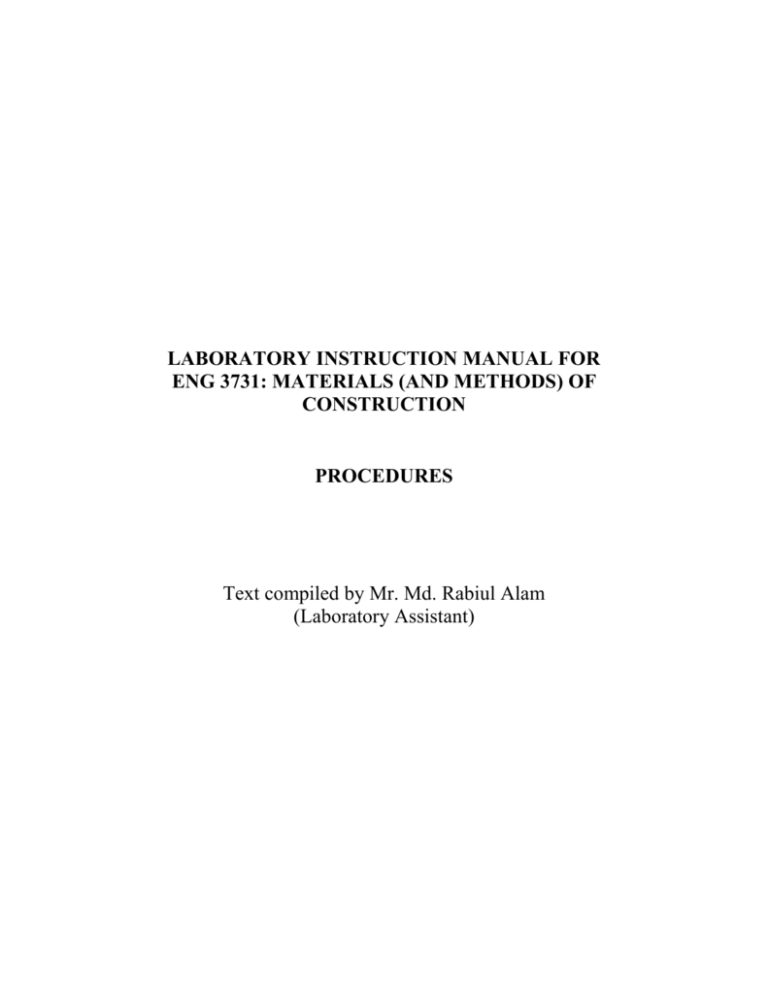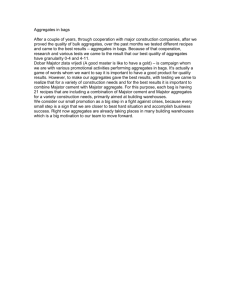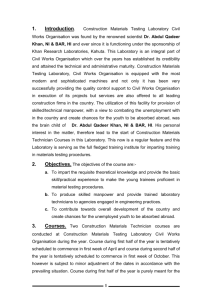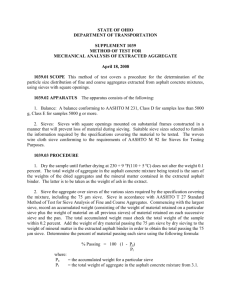Laboratory # 1
advertisement

LABORATORY INSTRUCTION MANUAL FOR
ENG 3731: MATERIALS (AND METHODS) OF
CONSTRUCTION
PROCEDURES
Text compiled by Mr. Md. Rabiul Alam
(Laboratory Assistant)
Laboratory # 1
“Tests on Aggregates”
(a) Fineness Modulus of Fine Aggregate”
(b) Fineness Modulus of Coarse Aggregates”
1
Laboratory I: Tests on Coarse and Fine Aggregates
Purpose: To obtain the fineness modulus, density, and voids ratio of fine and coarse
aggregate samples
Materials and Apparatus:
- sample of fine aggregate
- sample of coarse aggregates
- digital weighing scale
- sieve sifter for fine aggregates
- sieve sifter for coarse aggregates
- various cleaning brushes (point and wire)
Procedure:
Part 1: Sieve Analysis of fine aggregate
Step 1: Take 500g sample of fine aggregate (as per CSA code provisions, the
aggregates must be completely dry). This is determined by weighing the
material on a digital scale. Also weigh each sieve of the mechanical
sifter, and the pan, and record the weights.
Step 2: Place the aggregate in the top sieve of the well-cleaned mechanical sifter
(sieves used are # 4, # 8, # 16, # 30, # 50 & # 100). This apparatus is used
for shaking the aggregates (similar to the principle used in a paint-mixing
machine) and sieving them. The mechanical sifter has a bottom pan (to
receive the material passing # 100 sieve) and a lid to close the sifter during
the test. After placing the lid on the sifter, agitate the sifter for about 10
minutes.
Step 3: Determine the weight of aggregates that are retained in each of the sieves,
by weighing each of the sieves (along with the retained aggregates), and
subtracting the weight of each sieve. Also record all the weights of
aggregates retained in each of the sieves. To ensure that all materials are
collected, clean each sieve carefully using the proper type of brush. Use
the paint brush for the finer sieves, the copper brush for intermediate
sieves and the steel wire brush for the coarse sieves. Also verify whether
the sum of weights of aggregates, retained in all the sieves, and the bottom
pan is equal to the initial weight of the aggregates taken.
Step 4: Tabulate the data and determine the percent retained in each sieve. From
these values calculate the (cumulative) percentage of material that would
have been retained in the sieve if the whole volume of material was to be
sifted in that sieve alone. Then add the percentage of material retained in
all the sieves and divide by 100 to get the fineness modulus. Also prepare
2
a column to determine the cumulative percentage passing through the
sieve to plot the fineness modulus curve (as specified in CSA 23.1).
Step 5: Plot a graph of percent passing by weight vs sieve size, with the limits
specified in CSA standard A23.1 for fine and coarse aggregate sizes
superimposed.
Note: (1) All sieves have to be cleaned prior to experiment.
(2) See the sample calculations given at the end of this section.
PART 2: Sieve Analysis of Coarse Aggregate
Procedure:
Step 1: Take 5000 grams of coarse aggregates by weighing the material in a
digital scale. Weigh each of the clean sieve, along with the bottom pan,
and record their weights.
Step 2: Place the aggregates in the mechanical sifter (sieve sizes used are 1 ½”,
1”, ¾”, ½”, 3/8”, & #4). This apparatus is used for shaking the material
(similar to the principle of a paint-mixing machine) and sieving it.
Step 3: Determine the aggregates that are retained in each individual sieve, as
mentioned earlier in Part I, and record the data. To ensure that all
materials are collected, use the steel brush to clean each sieve.
Step 4: Tabulate the data and determine the percent retained, and the percentage
that would have been retained in each sieve, if that sieve alone was used
to sieve the whole volume. The fineness modulus is obtained by adding
the percentage of material retained in all the sieves and dividing it by
100.
Step 5: Plot a graph of percent passing by weight vs. sieve sizes.
Note: All sieves have to be cleaned prior to experiment.
Part 3: Bulk Density and Voids Ratio of Fine Aggregates
Step 1: Take a bucket (of volume, say, 2.5 litres) and weigh it. Place the
aggregates in the bucket (whose volume is already determined by
dividing the weight of the volume of water that is contained in the
completely filled bucket by the weight density of water. In addition, the
bucket must be properly dried before placing fine aggregate in it) to fill
1/3rd its capacity each time. Rod each portion 25 times. The steps are
3
repeated till the bucket in is filled with fine aggregates. Remove excess
aggregate using the tamping rod as a straight edge.
Step 2: Determine the weight of fine aggregates by weighing the bucket full of
aggregates, and subtracting the weight of empty bucket.
Step 3: Determine the bulk weight density of fine aggregates by dividing the
weight of the aggregates by the volume of the bucket.
Step 4: Also determine the volume of voids in the fine aggregate, using the
following equation.
% voids in fine aggregates =
{[(Sp. Gr. of fine aggregates)*w - bulk density]/[w*(Sp. Gr. of fine aggr.)]}*100
Part 4: Bulk Density and Voids Ratio in Coarse Aggregates
Repeat the procedures given in Part 3 for fine aggregates, and obtain the bulk
density and voids ratio for coarse aggregates.
Part 5: Sample Calculations for Fineness Modulus, Bulk Density and Voids Ratio
1.
Sieve analysis of a 1000-g sample of fine aggregates resulted in the following
data. Find the fineness modulus.
Sieve size
Weight
retained (g)
#4
26
#8
130
# 16
240
# 30
252
# 50
210
# 100
138
Calculations:
Sieve #
4
8
16
30
50
100
Weight retained Percent retained
(g)
26
2.6
130
13.0
240
24.0
252
25.2
210
21.0
138
13.8
Fineness modulus = 308/100 = 3.08
4
Percent coarser
2.6
15.6
39.6
64.8
85.8
99.6
Cumulative =
308
Percent finer
2.
Find the volume of voids in a 3 cubic yards of coarse aggregates, of bulk density
equal to 102 lbs/(cubic feet). The specific gravity of particles is 2.65.
% of Voids = [(SG*W - B)*100]/(SG*W)
Specific gravity, SG = 2.65
Density of water, W = 62.4 lbs/(cu. ft.)
Bulk density, B = 102 lbs/(cu. ft.)
% of voids = [(2.65*62.4 - 102)*100]/(2.65*62.4)
= 38.3%
Volume of voids = (38.3/100)*3 = 1.143 cu. yards
= 1.143*27 = 31 cu.ft.
5
Materials and Apparatus (Laboratory # 1):
Figure # 1
Coarse aggregate
Fine aggregate
Figure # 2
-----kg
Digital weighing scale
Figure # 3
Sieve for fine aggregates
Sieve for coarse aggregates
6
Labroratory # 2
“Tests on Cement Mortar”
(a) Normal Consistency of Cement Mortar
(b) Setting Time of Cement Mortar
(c) Compressive Strength of Cement Mortar Cubes
(Casting it earlier to test it later)
7
Laboratory II: Normal Consistency & Setting Time and the Determination of
Compressive Strength of Cement Mortar.
Purpose: To prepare samples of cement mortar specimens for: (1) Determination of
normal consistency and setting time tests; and (2) compressive strength of
mortar cement test.
Materials: - Sand
- Portland Cement
- Water
Apparatus: -
Vicat Apparatus
Digital weighing scale
Moulding tray for cubes
Beaker (for taking water)
Universal Testing Machine
Tamping rod
Mixing bowl
Trowel
A stop-watch
Procedure:
PART I: Normal Consistency and Setting Time
Step 1: Obtain 500g sample of Portland cement by weighing on the digital scale.
Step 2: Obtain 145ml of water in a beaker, which gives a water/cement ratio of
0.290:1 (this ratio may vary between 0.25 to 0.31).
Step 3: Combine both the Portland cement and water in the mixing bowl. Wait
approximately 30 seconds for water absorption.
Step 4: Start mixing using the mixing machine at a slow speed for 30 seconds.
Step 5: Turn off the machine for 15 seconds and scrape down the mortar from the
sides of the bowl using a scraping stick.
Step 6: Turn on the mixing machine again, for approximately 60 seconds at
medium speed.
Step 7: Within a minute, remove the mortar from bowl, press the mortar into the
conical ring and put it on the Vicat Apparatus, using a rectangular glass
(on bottom), and smooth the top with a trowel.
8
Step 8: In the Vicat Apparatus release the large-sized plunger (10 mm) to
penetrate the sample. Find the depth of penetration. If the penetration of
the plunger is 10 ± 1.0 mm, then the consistency is called the normal
consistency. Otherwise, decrease or increase the percentage of water and
mix the cement and water once again to carry out the above steps till the
normal consistency is obtained.
Step 9: Once the normal consistency is determined, then use the same paste to
determine the initial and final setting times. In this case, the 1-mmdiameter Vicat needle is allowed to penetrate the setting cement paste.
Start the timer when this cement paste was made.
Step 10: When the 1-mm-diameter Vicat needle penetrates to a distance of 25
mm, then the time taken by the cement paste (from its mixing to the
present time) is said to be its initial setting time.
Step 11: When the 1-mm-diameter Vicat needle just penetrates the surface of the
setting cement paste and stops, then the time taken from the time of mixing
of the paste to this time is called the final setting time.
PART II: Compressive Strength of Cement Mortar
Step 1: Obtain 1375 g sample of sand, 500 g sample of Portland Cement by
weighing material on a digital scale (in this the ratio of cement to sand is
1:2.75. This ratio can also be 1:1.5, 1:2, or 1:2.5, which can be tried by
other groups at the instructor’s discretion.
Step 2: Obtain 240 ml sample of water in a graduated cylindrical beaker, which is
equivalent to the specified water/cement ratio of 0.48:1 (the ratio can
vary from 0.45 to 0.60 and this ratio can be changed at the instructor’s
discretion).
Step 3: Combine the two dry samples (Portland cement and sand) in the mixing
bowl and mix for approximately 5 minutes.
Step 4: Slowly add water to the mixing bowl and mix the contents until the
desired consistency is achieved.
Step 5: Remove mixed contents from bowl and place it in even portions in five
cubes in the moulding tray, which has already been wiped on the inside
with the given oil.
Step 6: Tamp all five cubes to ensure uniform filling of the moulds. Smooth the
top with trowel.
9
Step 7: Cure the specimens for fourteen days in water so that it may attain the
desired design compressive strength.
Step 8: The cubes are removed from water, area of loading face of cubes
determined, and then placed in between plates of Universal Testing
Machine.
Step 9: Apply load to the specimen faces that are in contact with the machine.
Step 10: Apply load until failure, and note the load.
Step 11: Compute and record compressive strength of cement mortar.
10
Laboratory II: Normal Consistency and Setting Time and the
Determination of Compressive Strength of Cement Mortar.
Apparatus:
-------kg
Digital Weighing Scale
Vicat Apparatus
Mold tray for cubes
240 ml
Beaker
Cement
Mortar cubes
Universal Testing Machine
11
Laboratory # 3
“Tests on Concrete”
(a) Compressive Strength of Concrete Cylinders
(Casting now and Testing later)
(b) Slump of Concrete
12
Laboratory III: Slump Test and Compressive Strength of Concrete Cylinders
Purpose: To make and test concrete specimens for: 1) Slump test on concrete; and 2)
Compressive strength tests on cylinders at 7 and 28 days.
Materials and Apparatus:
-
cylindrical moulds for concrete cylinders (3)
conical hollow cylinder for slump test
sampling and mixing pans
scales
concrete
scoops
tamping rod
Concrete Mixer
Procedure:
Part I: Making and Curing of Concrete Compression Cylinder Test Specimens.
Step 1: Get the weight of material needed for making one concrete cylinder (150
mm diameter, and 300 mm high), knowing that the average weight
density of concrete is 2300 kgf/m3 (varies between 2,200 – for small
sized aggregates - to 2,500 kgf/m3 – for very large-sized aggregates).
Step 2: From the ratio of 4:2:1 (by weight) for coarse aggregate: sand: cement
calculate the material required knowing that we need enough concrete for
3 cylinders plus an extra 20% for wastage (the ratio of 4:2:1 can be varied
between 3:1 ½ :1 to 6:3:1, at the instructor’s discretion). Verify your
calculations with the instructor before proceeding with the experiment.
Step 3: Determine the amount of water, given that the ratio for cement to water
was specified as 1:0.55 (this ratio can vary between 0.45 to 0.60, and can
be varied at the instructor’s discretion).
Step 4: Weigh amount of coarse aggregate, sand, cement and water needed.
Step 5: All dry materials are added to the mixer, one after the other, and mixed
dry. First the coarse aggregate is added to the mixer and then the sand;
both are mixed dry for one minute, before cement is added to the mixer.
Then the cement is added and mixed thoroughly.
Step 6: Slowly add water to mixer and mix until the desired consistency is
obtained.
13
Step 7: Coat the inside of the cylinders with the specified mineral oil. Place the
concrete mixture in the cylinder to one-third of its volume, and tamp the
layer 25 times. Then fill to next one-third and once again tamp the layer 25
times. Finally fill the remaining portion of the cylinder with concrete and
tamp it once again 25 times.
Step 8: Level the top of mould with a trowel, and tap the sides to eliminate air
pockets
Step 9: Set moulds aside, and cure them in water, before testing them for 7 and 28
days strengths.
Step 10: Before testing the cylinders in the universal testing machine for their
compressive strengths, the cylinders must be capped with the proper
capping material (to load the concrete cylinders with a uniformly
distributed load, over its surface).
Part II: Slump Test
Step 1: Make concrete for the test, as given in Part I, sufficient for filling the
slump cone (approximately 40 to 50 lbs concrete).
Step 2: Carry out step 1 to step 6 as stated above, and fill the hollow conical metal
cone with concrete mixture in 1/3 portions making sure to rod 25 times
for each portion and to tap sides.
Step 3: Lift metal cone slowly straight up, and measure the vertical distance by
which the top surface of concrete settles (or slumps) down, to the nearest
10 mm with respect to the height of the slump cone.
14
Laboratory III: Slump Test and Compressive Strength of Concrete Cylinders
Apparatus:
Hollow cylindrical mould
Hollow conical mould for slump test
Scoop
Concrete Mixer
Sampling and Mixing Pans
15
Laboratory # 4
“Tests on Masonry”
(a) Modulus of Rupture of Brick (only demonstration)
(b) Compressive Strength of Brick (only demonstration)
(c) Compressive Strength of Concrete Masonry Block (only demonstration)
16
Laboratory IV: Modulus of Rupture and Compressive Strength of a Brick and
Compressive Strength of a Concrete Masonry Block
Purpose: To determine: i) the modulus of rupture: (ii) compressive strength of a brick;
and ii) compressive strength of a concrete masonry block
Materials:
- red clay bricks (2)
- masonry block (1)
Apparatus:
Universal Testing Machine
Procedure:
Part I: Modulus of rupture of brick
Step 1: Measure and record the dimensions and weight of the red clay brick.
Step 2: Place the brick in the Universal Testing Machine in the three-point
Bending mode..
Step 3: Place a steel plate on the top of brick and apply load to the upper surface
until rupture (bending fracture).
Step 4: Observe and record maximum load. Also explain the reason for the
characteristic failure, observed during testing.
Part II: Compressive Strength of Masonry Block and Clay Brick
Step 1: Measure and record the dimensions of masonry block (for both brick and
Masonry block).
Step 2: Place masonry block in the University Testing Machine between sheets of
wafer board.
Step 3: Apply load until failure occurs.
Step 4: Observe and record maximum load.
Step 5: Repeat steps 1-4 for the strength test on the clay brick.
17
Apparatus:
Brick placed in Universal Testing Machine, in the three-point bending mode
Masonry block placed in Universal Testing Machine
Note: The arrows represent the force applied by testing machine
18
Laboratory # 5
“Tests on Wood and Wood Fasteners”
(a) Flexural Stress in Wood at Proportional Loads
(b) Modulus of Elasticity and Modulus of Rupture
(c) Compression Strength of Wood Parallel to Grain
(d) Pullout Strengths of Steel Fasteners for Wood
19
Laboratory V: Flexural and Compressive Strength Tests on Wood and Wood
Fasteners.
Purpose: To determine (i) Flexural strength of wood at proportional limit; (ii) Modulus
of rupture (at failure of beam in flexure test); (iii) Modulus of elasticity of
wood (within the proportional limit range); (vi) Compressive strength of
wood at failure; and (v) Pullout strengths of metal fasteners for wood (various
types of nails).
Materials and Apparatus:
(a)
(b)
(c)
(d)
(e)
Test samples of wood and metal fasteners
Universal testing machine
Deflecto-meter
Dial gauge
Measuring tape
Procedure:
I.
For parts (I), (ii) and (iii): Flexural Strength Tests on wood
Step 1: Measure dimensions of wood samples.
Step 2: Position the wood sample on the bending supports of the Universal testing
machine, over a span length of 28 inches, and place the deflectometer,
below the center of the beam specimen.
Step 3: Apply the load at the center of the specimen at equal intervals and at a
uniform rate (75 lbs per minute).
Step 4: The load and deflection values are recorded at the above intervals (remove
the deflectometer after the elastic limit of wood has been exceeded).
Step 5: Continue to apply the load at equal intervals till the specimen fails in
flexure and record the maximum load and the type of failure in wood.
Step 6: Plot the load vs. deflection curve and determine the slope of the diagram
(P/), where P is any load within elastic limit and is the corresponding
deflection (this gives the stiffness of the beam).
Step 7: Calculate the flexure strength at the end of the elastic limit of P vs. plot.
Step 8: Calculate the modulus of elasticity of the wooden beam [y = PL3/(48 EI)].
20
Step 9: Calculate the modulus of rupture of wood= ( Pmax L) /( 2bh 2 ) .
Step 10: Tabulate the results and present in a report form.
II.
For part (iv) - Compressive Strength of Wood
Step 1: Measure the dimensions of the wood sample.
Step 2: Position the wood specimen under the cross-head of testing machine (at
the center).
Step 3: Apply the load till the specimen fails in compression.
Step 4: Determine the compressive strength of wood as [Applied Load/(crosssectional area)].
Step 5: Present the results.
III.
For part (v): Pullout Strengths of Wood Fasteners
Step 1: Insert the steel fasteners (nails) into wood.
Step 2: Fix the wood onto the test machine.
Step 3: Fasten the nail to the top cross-head of the testing machine and apply
tensile load (to pull out the nail fastener).
Step 4: Note the maximum load required for pulling out the nail specimen.
Step 5: Present the results.
21
Laboratory V: Flexural and Compressive Strength Tests on Wood and Wood
Fasteners.
22








